Following some of the best years in Chicago Blackhawks history, the franchise entered into a two-season playoff drought, which left fans old and new wondering how long it would take for the team to become serious contenders again. Then, this offseason, the Blackhawks announced that Andrew Shaw—who won the Stanley Cup with Chicago in 2013 and 2015—would bereturning for the 2019-20 season.
While the return of a previous Stanley Cup champion might bring thoughts of another playoff run, fans should keep their nostalgia for the Blackhawks’ winning rosters in perspective. Since the 2010 victory, the team has now reacquired eight notable champions, and the players prior to Shaw didn’t often bring the results fans hoped for.
Kris Versteeg
After getting his name etched in the Cup in 2010, Kris Versteeg was the first to come back to the Blackhawks in the 2013-14 season. Having played with the Toronto Maple Leafs, Philadelphia Flyers and Florida Panthers in only two seasons away, Versteeg returned to score 29 points in 63 games with the Blackhawks in 2013-14, and 31 points during their championship season in 2014-15.
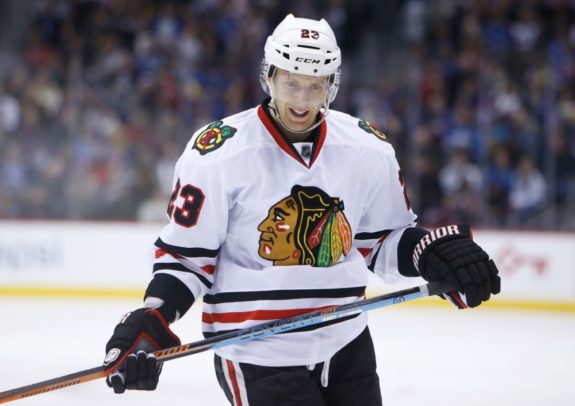
His numbers were not a complete return to the 80 games and 46 points of his 2010-11 season with the Blackhawks. More importantly, though, Versteeg served as one-third of the dynamic Versteeg-Brad Richards-Patrick Kane line during the 2014-15 season. Versteeg’s presence on that explosive second line helped solidify the Blackhawks’ spot in the playoffs, and after being benched early on (from ‘Blackhawks’ Kris Versteeg Making the Most of His Restored Ice Time,’ Chicago Tribune, 06/14/2015), he returned for the Final where he contributed an assist on a game-winning goal.
Versteeg is the only returning Blackhawk to help the team win another Cup upon his return so far. This would seem to make Versteeg not only the first, but the most successful of the seven returning champs.
Andrew Ladd
After serving as captain of the Winnipeg Jets in five and a half seasons away, Andrew Ladd was the second Blackhawk to return when he was traded from Winnipeg during the 2015-16 season. His 34 points and minus-10 rating with the Jets during that season didn’t promise much. Although the results may have been disappointing, it also wasn’t that surprising when he played only 19 games with the Blackhawks before he returned to free agency at the close of the season.

The Blackhawks as a whole were at the start of their decline that season, as they were eliminated in the first round of the playoffs by the St. Louis Blues. The team also didn’t lose a major player for their future in the trade, as young center Marko Dano has not had an impressive NHL run since his departure. So while Ladd’s brief return may not have led to another championship for the Blackhawks, the trade also didn’t necessarily have a negative impact on the team’s future.
Brian Campbell
Brian Campbell was one of the next Blackhawks to return in the 2016-17 season. As this was his final season, he was not the fast, offensive-minded player he had been. However, Campbell still put up respectable numbers compared to some other Hawks’ returns, remaining at plus-12 and scoring 17 points. Additionally, it’s important to keep his return in the context of his career, as the Blackhawks most likely did when they signed him.
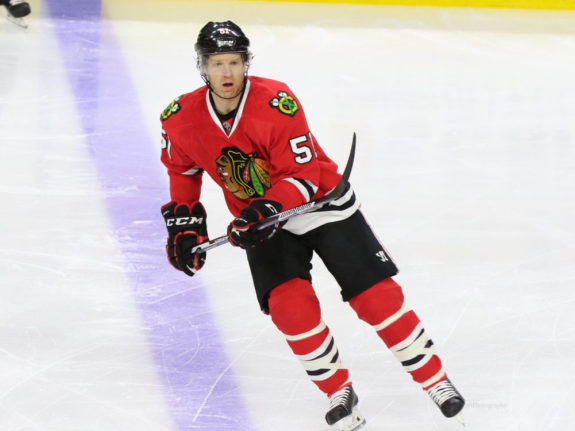
When Chicago offered him a one-year, $2.25-million contract for his 17th season in the NHL, the organization could not have expected the play of the 29-year-old who had originally joined their team eight years prior. Rather, he inexpensively filled a gap in the team’s crumbling defense. Campbell was also set on finishing his career in Chicago, saying in a press conference that he “wouldn’t want to retire any other way but a Blackhawk.” Upon his retirement, he joined the Blackhawks front office, showing loyalty to the team outside of any impact his comeback season may have provided.
Johnny Oduya
As a 2013 champion with the Blackhawks, Johnny Oduya also returned for the 2016-17 season. Playing only 15 games in his return with Chicago, Oduya helped patch up the Blackhawks’ defense along with Campbell, but didn’t leave much of a mark that season. The Blackhawks were swept by the Nashville Predators in Round 1 of the playoffs, quickly ending Oduya’s brief second stint in Chicago and sending him back into free agency to be picked up by the Ottawa Senators.
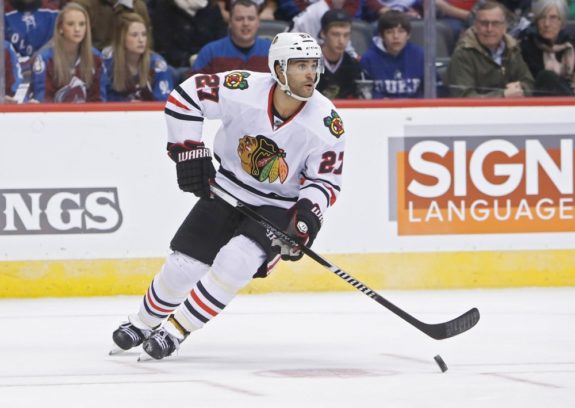
Much like Campbell, Oduya returned to Chicago later in his career. Trading for him during his 11th season in the NHL, the Blackhawks may have been hoping for more, but they couldn’t have been expecting a complete game-changer. Especially after Oduya won two Stanley Cups in Chicago in 2013 and 2015, it’s safe to say that he won’t be remembered for his 2017 playoff performance.
Patrick Sharp
If any of these players felt destined to return to Chicago, it was Patrick Sharp. Having played nine seasons with the Blackhawks, won three Stanley Cups with the team and essentially helped rebuild the franchise, Sharp’s legacy with the organization was already secured before his return in 2017.

It’s good that his legacy was not dependent on the 2017-18 season, as that year saw the Blackhawks miss the playoffs for the first time in nine years. Sharp himself scored only 21 points, and saw his average ice time drop to 12:53 per game. Similarly to Campbell’s contract, this one-year, $800,000 deal was really an allowance for Sharp to retire in Chicago, and fans can still see Sharp regularly with another ex-Blackhawk, Adam Burish, as an analyst for NBC Sports (from ‘Patrick Sharp returns to Stanley Cup Final — as analyst for NBC, Chicago Sun-Times, 05/30/2019).
Brandon Saad
Brandon Saad had possibly the most disappointing return of these seven players. Having scored 52 points in 82 games during his second championship season with Chicago in 2014-15, he was subsequently traded to the Columbus Blue Jackets (in a deal that actually saw Jeremy Morin’s short and unimpressive return to Chicago). Saad scored 55 goals his two seasons with Columbus.
Then, in 2017, Saad rejoined the Blackhawks, but at the cost of budding superstar Artemi Panarin. Saad scored only 35 points in the 2017-18 season. Although he brought his scoring back up to 47 points last season, his two comeback seasons resulted in a plus/minus of minus-seven and minus-nine, respectively (compared with plus-seven in 2014-15), signaling his play may not be at the same level as Blackhawks fans once saw. The Blackhawks also missed the playoffs both season since Saad came back.
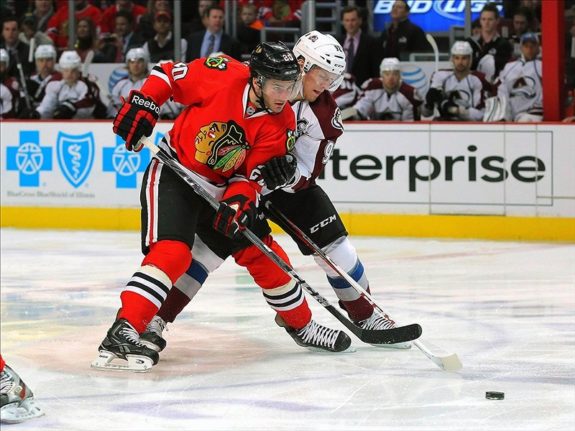
Because each player had similar effects on the salary cap at the time, it’s hard not to consider Saad’s play in light of the loss of Panarin, who scored 87 points last season with the Blue Jackets (and who just signed a $81.5 million contract with the New York Rangers). However, as the only returning Blackhawk (besides Shaw) with additional seasons left in Chicago, it’s possible he may still prove to be a valuable re-acquisition.
Marcus Kruger
After playing his first seven seasons with the Blackhawks, Marcus Kruger had one season away with the Carolina Hurricanes before his return in 2018. While the trade brought back the two-time Stanley Cup champion, for many fans, the first deal centered primarily around freeing Marian Hossa’s cap space for the Blackhawks, sending Hossa, Vinnie Hinostroza and Jordan Oesterle to the Arizona Coyotes. Although Hossa did not play for the Coyotes that season, the trade was certainly bittersweet, as he was one of the players largely credited with bringing Chicago its three recent championships.
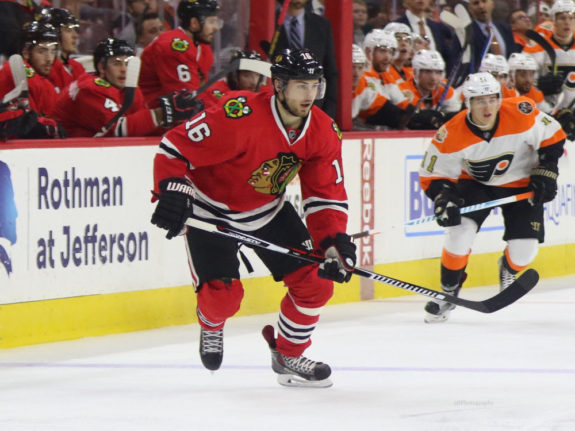
The 2018-19 season was the second consecutive year that saw the Blackhawks eliminated from playoff contention. Like many of the returning Blackhawks, Kruger filled a role but did not overly impress, scoring only 12 points. He recently signed a contract to play for the ZSC Lions in Switzerland, so he mostly likely also finished his NHL career with the Blackhawks.
The Hope for Shaw
Most of these players returned to a very different team than the one they had left, and returned as different players themselves. Beyond Saad, who may have been expected to perform at a career high, many returned to fill a distinct spot from the one they had filled when they had last worn the red jersey. Some came back only to finish out careers in the city where they had once hoisted the Cup.
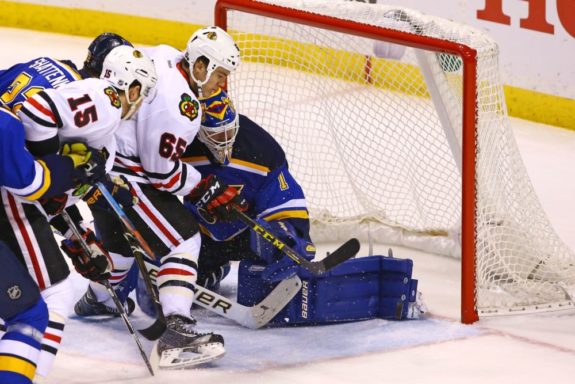
The hope for the Blackhawks with Shaw’s re-acquisition, then, is that he is coming off of a career high season with the Montreal Canadiens. If Shaw can keep up the growth he exhibited last season, he could break the mold of unimpressive Blackhawks re-acquisitions.